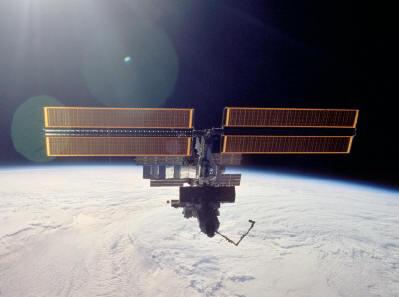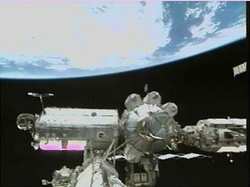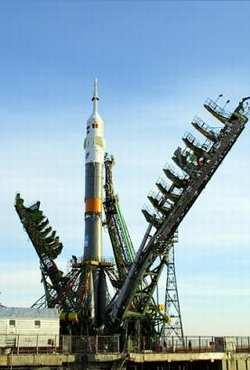Moscow Steps Up To Fill Shuttle Void
Doubling back on its previously stated position regarding
funding for the International Space Station, the Russian Cabinet
Thursday pledged extra money to build more spacecraft that would
service the international space station, while NASA teams and
federal investigators in the US try to figure out what happened to
the ill-fated shuttle Columbia.

Money Troubles
Up to now, Russian officials had contended that it could not
build extra ships for the international space station without a
U.S. financial contribution. But something has changed at the
Kremlin.
 "We
will undoubtedly have to carry the main workload, having to perform
additional launches and flights to the station," Prime Minister
Mikhail Kasyanov said at the beginning of the Cabinet session. "We
can't postpone this decision."
"We
will undoubtedly have to carry the main workload, having to perform
additional launches and flights to the station," Prime Minister
Mikhail Kasyanov said at the beginning of the Cabinet session. "We
can't postpone this decision."
Yuri Koptev, director of the Russian Aviation and Space Agency,
told reporters later that the Cabinet had approved the early
release of the $38 million originally set for the second half of
the year to speed up construction of extra ships.
Koptev said the government had also tentatively promised to
bolster the space station's budget from $130 million this year to
$240 million next year.
NASA has said that any potential American funding is constrained
by U.S. legislation barring additional payments to Russia's space
agency unless Washington confirms Russia has not transferred
missile technology or nuclear, chemical or biological weapons to
Iran in the previous year.
With US-Russian ties a bit strained over the war in Iraq, don't
look for Congress to waive that bill. US officials also point out
Russia wasn't living up to its obligations to service the
station.
Thursday, Koptev said Moscow will continue holding out for
financial help to build new spaceships, but acknowledged that
American space shuttles had done some of the work on the station
that the cash-strapped Russian program was supposed to do, but
couldn't.
What Goes Around Comes Around
 "Now it's coming back to us and it's hard to
complain about that," he said.
"Now it's coming back to us and it's hard to
complain about that," he said.
The alternative is to leave the station temporarily unoccupied.
But that could become a safety issue, Koptev said. Since allowing
its own Mir space station to fall out of orbit in March 2001,
Russia's manned space program has hinged entirely on the
international outpost.
Russian Soyuz crew capsules and Progress cargo ships are the
only link to the 16-nation station as the American shuttle fleet
remains grounded pending an investigation into the
Columbia disaster. Soyuz ships serve as lifeboats for the
crew and must be rotated from the station every six months, while
unmanned Progress ships ferry fuel, water and other supplies.
The Taxi's In The Barn
In the past, U.S. space shuttles performed rotation of the
station's long-term crew, while Russia used Soyuz capsules to earn
extra cash by bringing space tourists on weeklong missions to the
station.
Because of the break in shuttle flights, U.S. astronaut Edward
Lu and Russian cosmonaut Yuri Malenchenko are to ride a Soyuz to
the station in late April or early May for a six-month mission.
As part of the crew rotation, the station's current residents,
Americans Kenneth Bowersox and Donald Pettit and Russian Nikolai
Budarin, will return to Earth in another Soyuz capsule presently
docked at the station.
 ANN's Daily Aero-Linx (05.06.25)
ANN's Daily Aero-Linx (05.06.25) ANN's Daily Aero-Term (05.06.25): Ultrahigh Frequency (UHF)
ANN's Daily Aero-Term (05.06.25): Ultrahigh Frequency (UHF) ANN FAQ: Q&A 101
ANN FAQ: Q&A 101 Classic Aero-TV: Virtual Reality Painting--PPG Leverages Technology for Training
Classic Aero-TV: Virtual Reality Painting--PPG Leverages Technology for Training Airborne 05.02.25: Joby Crewed Milestone, Diamond Club, Canadian Pilot Insurance
Airborne 05.02.25: Joby Crewed Milestone, Diamond Club, Canadian Pilot Insurance





